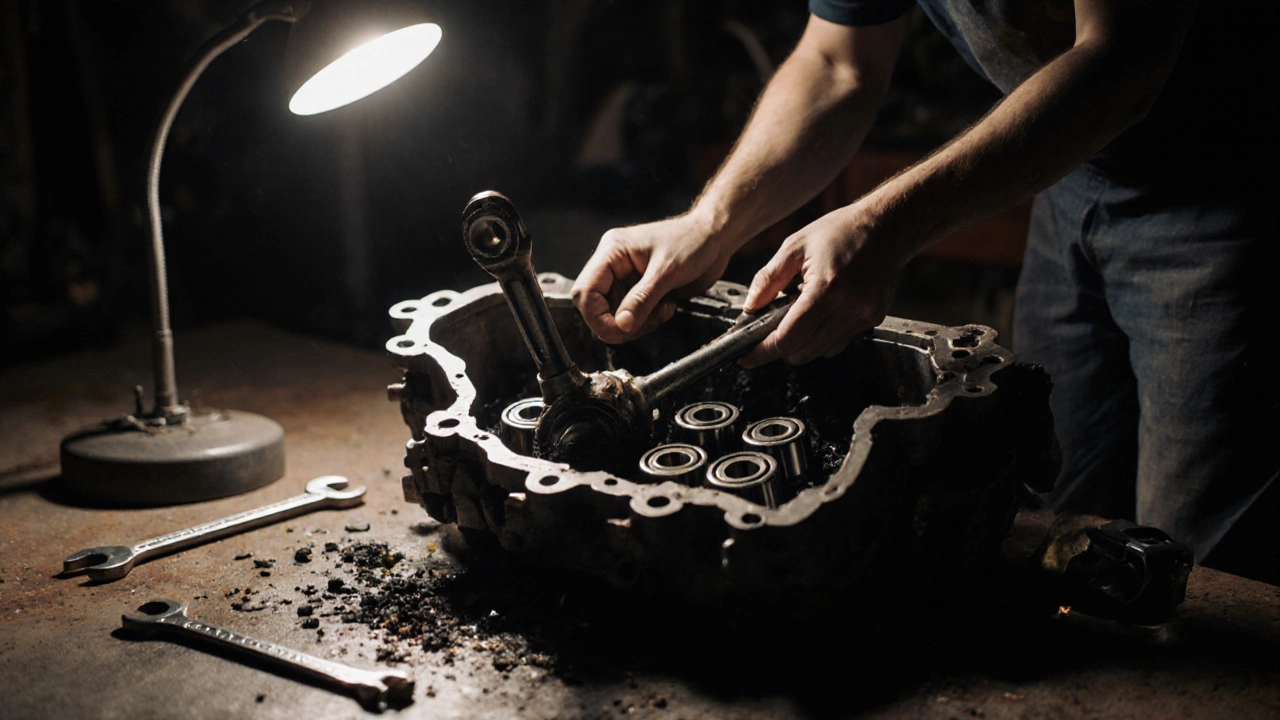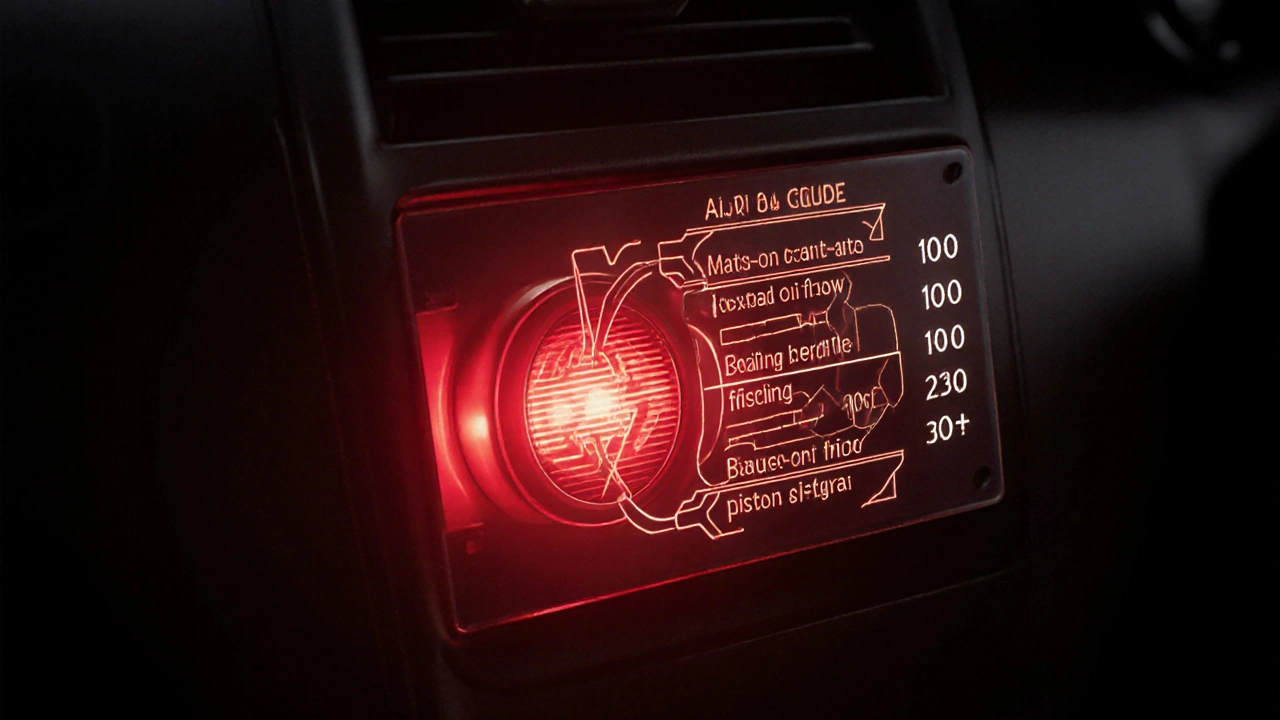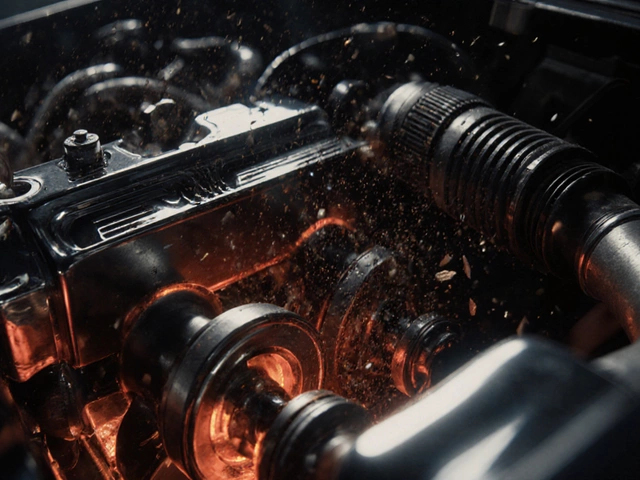Engine Oil Failure Calculator
This calculator estimates how quickly engine damage occurs when oil is completely absent, based on the article's findings. Engine failure happens rapidly—typically in under 30 seconds.
Estimated Failure Time
Most drivers know oil keeps the engine running smoothly-but few realize how fast things fall apart when it’s gone. You might think a car can idle for a few minutes without oil, or maybe even drive a mile. The truth? Engine oil is the difference between a smooth ride and a $5,000 repair bill-and it can vanish in under 30 seconds.
What Happens the Moment Oil Disappears
Engine oil doesn’t just lubricate. It cools, cleans, and seals critical parts under extreme heat and pressure. When oil is gone, metal meets metal-fast. The first components to suffer are the camshaft lobes, lifters, and main bearings. These parts move thousands of times per minute. Without oil, friction spikes from 0.1 to over 0.8 coefficient of friction. That’s like grinding two pieces of sandpaper together at 3,000 RPM.
Within 10 to 15 seconds, the engine starts overheating locally. Temperature spikes above 400°F in the bearing surfaces. Aluminum pistons begin to soften. The oil pump, if still spinning, is now just moving air. You won’t hear anything dramatic at first. No smoke, no loud bang. Just a quiet, creeping death.
The 30-Second Rule: No Oil, No Mercy
Most engines will survive 30 seconds without oil before irreversible damage begins. That’s not a guarantee-it’s a window. Some engines, especially older ones with looser tolerances, might limp along for 45 seconds. Newer high-revving engines, like turbocharged 2.0L four-cylinders, can seize in under 20 seconds.
Real-world example: A mechanic in Manchester pulled over a driver who’d ignored the oil warning light for 40 miles. When he checked the engine, the crankshaft had spun its bearings. The connecting rods had punched through the engine block. The car didn’t explode-it just stopped. One moment it was running, the next, it was scrap.
Even if the engine doesn’t seize right away, the damage is already done. Microscopic metal particles from the bearings get swept into the oil passages. They score cylinder walls. They clog the oil filter. They grind down the camshaft. You might think you got lucky. You didn’t.
Why You Can’t Just Add Oil Later
Some people think: “I’ll just stop, add oil, and keep going.” That’s a myth with deadly consequences. Once metal surfaces have scored or melted, adding oil won’t undo the damage. The piston rings might be cracked. The valves could be bent. The cylinder walls are no longer round-they’re egg-shaped from heat distortion.
Even if the engine turns over after adding oil, it’s running on borrowed time. You might get 50 miles. Or 5. But you’re not fixing it-you’re delaying the inevitable. That’s why mechanics won’t even try to start a seized engine without a full teardown. Restarting it risks shattering the crankshaft or blowing the head gasket.

What the Warning Light Really Means
Your car’s oil pressure warning light isn’t a suggestion. It’s a final scream. Most modern cars trigger the light when oil pressure drops below 5 psi-about 10% of normal operating pressure. At that point, critical parts are already starving. The engine doesn’t wait for you to pull over. It starts failing immediately.
Some drivers ignore the light because they’ve seen it flicker on briefly after a sharp turn. That’s normal-it’s the oil sloshing away from the pickup tube. But if it stays on, even for a few seconds, shut the engine off. Right now. Don’t wait. Don’t check your phone. Don’t find a parking spot. Stop the engine.
How Long Can a Car Idle Without Oil?
Idling doesn’t save you. In fact, it makes things worse. At idle, oil pressure is already low. Without oil, the lifters collapse. The camshaft doesn’t get cooled. The timing chain tensioner loses lubrication and starts to rattle. You might think idling is gentle. It’s not. It’s just slower destruction.
Tests by the Society of Automotive Engineers show that an engine idling without oil can suffer bearing failure in 18 to 22 seconds. That’s faster than you can say “I didn’t think it would happen.”
Real Cases: What Actually Happens Inside
Take a 2018 Honda Civic with 90,000 miles. Owner changed the oil at 85,000 but never checked the level. A loose filter gasket leaked out 1.5 quarts over three weeks. The car started making a ticking noise. He ignored it. One morning, it wouldn’t start. The engine had locked up. The connecting rod had broken and pierced the block. Repair cost: $4,200. Car value: $3,800.
Another case: A delivery van in Leeds ran with no oil for 12 miles because the dipstick was broken and the owner assumed “it’s fine.” When it died, the pistons had welded to the cylinder walls. The engine had to be replaced. Insurance denied the claim-because lack of maintenance voided coverage.
These aren’t rare. In the UK, over 12,000 engine failures each year are linked to low or no oil. Most are preventable.

How to Prevent This From Happening
There’s no mystery here. Preventing oil starvation is simple:
- Check oil level every time you fill up with fuel. Takes 30 seconds.
- Look for leaks under the car. A dark puddle near the engine? Get it checked.
- Change oil every 5,000 to 7,500 miles, or as your manual says. Synthetic oil lasts longer-but still wears out.
- Listen. A new ticking or knocking sound? Don’t ignore it. It’s not “just the cold.”
- Replace the oil filter every time you change oil. A clogged filter starves the engine too.
Most people don’t check oil because they think “the car tells me.” But warning lights come after damage has started. You’re not a passenger in your car-you’re its caretaker.
What If You Already Drove Without Oil?
If you drove with no oil and the engine is still running, don’t panic-but don’t celebrate either. Turn it off. Let it cool. Then call a mechanic. Don’t try to restart it. Don’t add oil and drive to the garage. Tow it.
A good mechanic will:
- Check oil pressure with a manual gauge
- Remove the oil pan to inspect bearings
- Use a borescope to look inside the cylinders
- Check for metal shavings in the oil filter
At that point, they’ll tell you if it’s repairable or if you need a new engine. There’s no middle ground. Either you rebuild it properly-or you replace it. There’s no shortcut.
Bottom Line: Oil Isn’t Optional
Your engine doesn’t need oil to run. It needs oil to survive. The difference between 30 seconds and 30 minutes isn’t luck-it’s design. Modern engines are tighter, hotter, and faster than ever. They leave no room for error.
Check your oil. Listen to your car. Don’t wait for a warning light. If you’re not sure how to check it, ask someone. Watch a video. Learn. It takes less time than your morning coffee.
And if you ever hear that faint ticking sound? Don’t wait. Stop. Check. Fix. Because once the oil is gone, the engine doesn’t wait for you to catch up.
